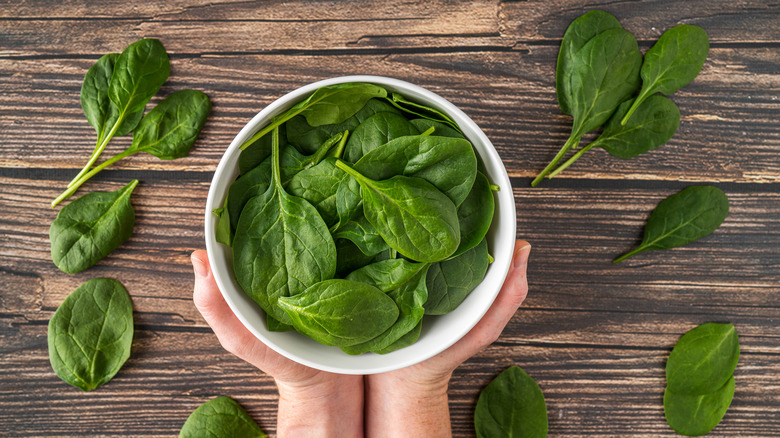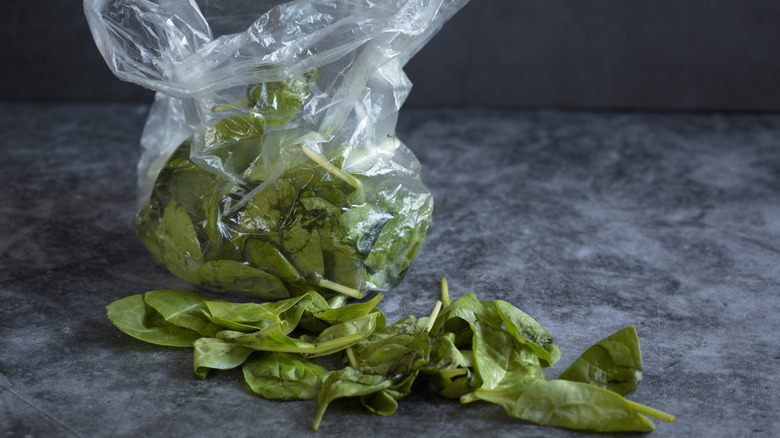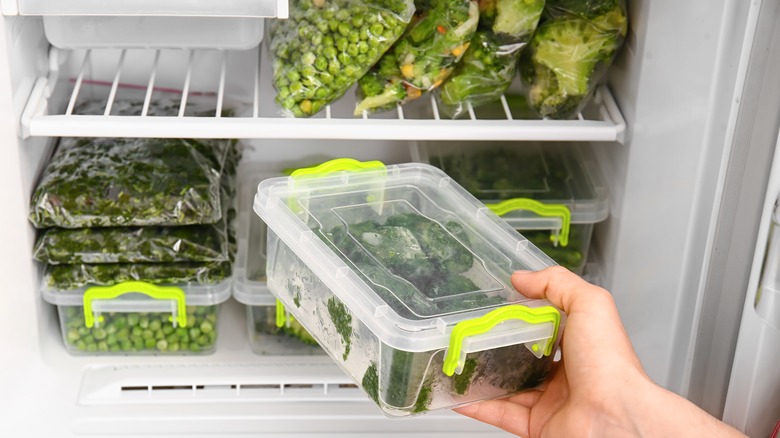Here's What Causes Slime To Form On Old Spinach
Spinach is a great addition to just about any salad, smoothie, sandwich, or stir fry. This healthy green vegetable packs a huge nutritional punch into a small package, making it one of the smartest choices one can make for their diet. A single cup of raw spinach contains just seven calories, but offers a notable amount of fiber, iron, calcium, magnesium, potassium, Vitamin A, and folate, according to Medical News Today.
Regularly consuming these leafy greens can add a serious boost to your overall health and wellness. Spinach is a great source of antioxidants, which have been shown to help reduce the risk of developing serious illnesses like diabetes and cancer, according to Healthline. It also can help support eye, bone, and heart health, while its high levels of vitamin C, vitamin E, and magnesium help boost the immune system, per WebMD. And while just about any green vegetable is a smart diet choice, spinach has a light, slightly sweet taste, according to Foodiosity, that tends to be more tender and flavorful than lettuce but less bitter than kale – the perfect balance if you struggle to work those pesky greens into your diet.
However, there is one big downside to this versatile and nutritious vegetable. Anyone who has ever purchased spinach knows its shelf life is frustratingly short. While one might be tempted to stock up on spinach when they are trying to eat healthily, the food will inevitably become a soggy, slimy mess before too long. But why does spinach get slimy and gross so quickly, and is there anything you can do about it?
Why does spinach get slimy?
Spinach gets slimy or wet, so easily because it is already at least 90% water, according to a study in Nutrition Reviews. When spinach leaves break apart, they leave behind wet plant residue that looks off-color and slimy. This residue is actually the result of the spinach's cell membranes breaking down and decomposing, says Eat or Toss. As the spinach breaks down, it begins to release some of the large amount of water in its own leaves, which is why old spinach develops a wet, slimy feel.
Spinach can also spoil as the result of external moisture, such as condensation, that settles on the leaves, according to Eating Well. Basically, once any water comes into contact with the spinach, from inside or outside, it will weaken the leaves' cell membranes and the plant will eventually begin to start rotting. The end result is shriveled, sludgy leaves that are neither tasty nor safe to eat. Decomposed plant matter can become a breeding ground for microbes and even dangerous bacteria like E. coli. Not to mention, slimy, decomposing spinach doesn't look or taste (or sound) all that appetizing. So once you notice your spinach is beginning to develop an unappetizing layer of wet grime, it is a good idea to toss it or compost it and buy a fresh package.
How to keep spinach fresh
Raw spinach usually keeps for no longer than a week in the fridge, per Still Tasty. However, it can spoil and slime even more quickly if it is stored wrong. The best way to extend the life of spinach is to keep it away from excess moisture. Spinach should be stored in a dry, airtight container in a cold environment to help prolong its freshness. Gently wrapping the spinach leaves in a paper towel before storing can also help soak up excess moisture and keep the leaves crisp and fresh, according to All Recipes.
In addition to the packaging, you should also be mindful of where you are placing your spinach inside the refrigerator. Spinach leaves are delicate, and once they break apart, they become prone to spoiling due to the release of moisture from the damaged cells. Therefore, if they are carelessly tossed inside a drawer where they may accidentally be roughly handled, or where something heavy may be placed upon them, they are more likely to go bad more quickly, according to Eating Well. Therefore, it can be a good idea to store spinach in hard, airtight containers to protect the leaves from getting crushed, or place a bag on top of other items.
Following these simple guidelines is a good way to make the most of your produce's life, but leafy green vegetables will never have a terribly long shelf life — so it is still best to purchase your spinach as close to the day you plan on eating it as possible.


